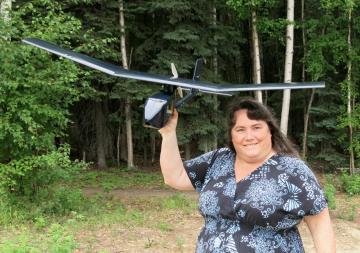On a cool spring morning in the mountains of southwest Washington, 12-year old Cathy Cahill helped her dad plant scientific instruments around the base of trembling Mount St. Helens. A few days later, the volcano blew up, smothering two of his four ash collectors. When he gathered the surviving equipment, Cathy’s father found a downwind sampler overflowing with ash laced with chlorine.

By Ned Rozell | Geophysical Institute
July 23, 2013
Tom Cahill of the University of California, Davis, wrote a paper on this surprising result; editors at the journal Science were impressed enough to publish it.
Tom’s teenage daughter was not a co-author on her dad’s Mount St. Helens paper in the early 1980s, but her name has appeared next to his in a few journals since then. Now 44, Cathy continues to stamp her own mark on the field of atmospheric science. The University of Alaska Fairbanks professor has captured and examined the particles floating in air breathed by U.S. servicemen and woman in far-off deserts. She has invented an air-sensing system that alerts pilots they are encountering volcanic ash particles. She also spoke on a national radio program about the bitter, smoky midwinter air of her adopted home of Fairbanks, Alaska.
And she now commands a fleet of 161 unmanned aerial vehicles. Cahill will fly 160 AeroVironment Ravens (which have a wingspan, at 55-inches, more like a sandhill crane’s) and one Boeing Insitu ScanEagle (which weighs 10 times more and has the 10-foot spread of a California condor). She will use them to sniff the air around volcanoes and inside wildfire plumes.
Cahill will also enlist the drones to expand her ground-based studies of air from Afghanistan, Djibouti, Kuwait and other regions in which Americans are stationed. For years, she has helped officials with the U.S. Army Research Lab see the tiny particulates wafting in the air above urban battlefields.
“The military has a healthy population, but we’re still seeing increases in respiratory diseases in soldiers that are coming home,” she says in her office that overlooks the flats of the Tanana River valley, home to both an Army post and an Air Force base. “They call it ‘the Iraq crud’ — you come back hacking. We’re trying to find out what might be responsible for some of these respiratory ailments.”
Along with the health of men and women, military officials have also asked Cahill what particulates are doing to their machines.
“A lot of soils behave like volcanic ash,” Cahill says. “That’s part of the reason engines tend to get destroyed in Saudi Arabia. The soils there can melt in the engines. And soils in high enough concentrations also abrade. If you have high concentrations and you fly through them again and again, you’re going to wear out your aircraft.”
Geophysical Institute machinist Greg Shipman and an electronics specialist, David Giesel with the unmanned aircraft program, helped Cahill convert her ground-based air samplers from a 40-pound Pelican case to an eight-pound unit that fits in the nose of an unmanned aircraft. Her air samplers will lead the way into volcanic ash clouds and choking plumes of singed black spruce.
Going airborne is just another step in the life of the little girl who followed her father’s footsteps over a volcano many years ago.
“My entire career’s thread is aerosols — the sources, atmospheric transformations, transport and impacts,” she says. “If you’re studying the atmosphere, you want to be able to go up in it.”
Since the late 1970s, the University of Alaska Fairbanks’ Geophysical Institute has provided this column free in cooperation with the UAF research community. Ned Rozell is a science writer for the Geophysical Institute
